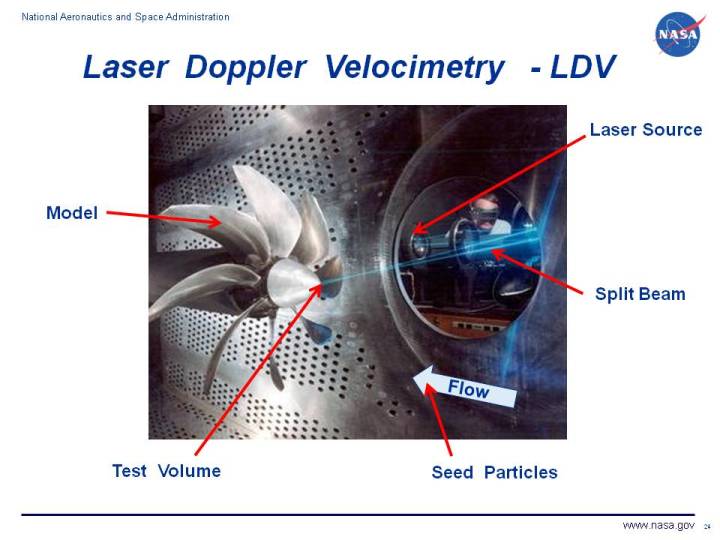
Aerodynamicists use
wind tunnels
to test
models
of proposed aircraft and engine components.
During a test, the model is placed in the
test section
of the tunnel and air is made to flow past the model.
Various types of instrumentation are used to determine the forces
on the model.
In some wind tunnel tests, the model is instrumented to provide
diagnostic information
about the flow of air around the model. Diagnostic instrumentation includes
static pressure taps,
total pressure rakes,
hot-wire velocity probes, and
laser Doppler velocimetry.
A diagnostic test does not provide overall aircraft performance, but helps the
engineer to better understand how the fluid moves around and through the model.
Depending on the type of instrumentation used in the experiment,
steady state flow or unsteady, time-varying, flow information can be obtained.
On this page, we will discuss the operation of the laser Doppler velocimetry,
or LDV, system.
Considering the figure, the LDV system uses a laser that sits outside the tunnel.
Optics are used to split a laser beam into two parallel beams that are sent into the
tunnel and focused on a small test volume near the model.
Because of wave interference, a fringe pattern is
generated in the test volume. Seed particles are introduced upstream in the flow and as the
seeds pass through the fringes they are illuminated. A photodetector measures the frequency
of the pulses as the particle passes through the fringes. The frequency f is proportional
to the velocity of the particle V, the half angle b between the two beams, and
the wavelength lambda of the laser light according to this equation:
f = 2 * V * sin(b) / lambda
There are two basic methods used to detect the passing of the seed particles, the forward scatter
technique and the backward scatter technique. In the forward scatter mode, the detector is placed on
opposite side of the tunnel from the laser source. In the backward scatter mode, the detector and
laser are mounted on the same side of the tunnel. There are advantages and disadvantages to both modes.
The forward scatter can use a lower powered laser, but requires optically flat clean windows on both sides
of the tunnel test section. The backward scatter requires a higher powered laser, but only one window.
The forward scatter can encounter problems from the model blocking the transmitted beams,
the blockage does not occur in the backward scatter mode.
A typical seed for an LDV system is an atomized light oil spray. The assumption that the particles
follow the flow is true for small particles. If the particles become too large (10 - 15 x 10-6 m)
they do not follow the flow. Of course, spraying the seed into the tunnel creates a cleaning problem
when the test is completed. Laser velocimeters, optics, and electronic signal processors are all
commercially available.
Navigation ..

- Beginner's Guide Home Page
|
